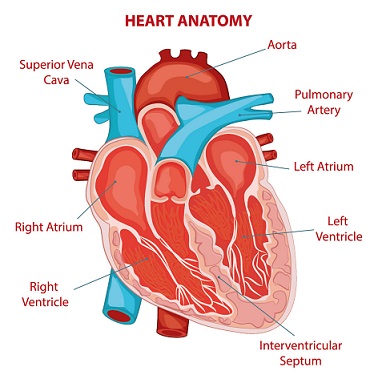 The heart is one of the most important organs in mammals and is made of muscular tissue. It pumps blood around the body to other vital organs, giving them oxygen for aerobic respiration. In one circulation of the body, blood enters and leaves the heart twice. Arteries and veins carry blood around the body. Arteries take blood away from the heart and veins return blood to the heart. If you struggle to remember this, think Arteries take blood Away.
The heart is one of the most important organs in mammals and is made of muscular tissue. It pumps blood around the body to other vital organs, giving them oxygen for aerobic respiration. In one circulation of the body, blood enters and leaves the heart twice. Arteries and veins carry blood around the body. Arteries take blood away from the heart and veins return blood to the heart. If you struggle to remember this, think Arteries take blood Away.
The Route that Blood Takes Around the Body
When blood first arrives back at the heart, it has very little oxygen in it. The blood arrives from the Vena Cava veins and into the Right Atrium. Then it passes through the Tricuspid Atrioventricular Valve and reaches the Right Ventricle. Then the blood is pumped out through the Pulmonary Artery. The blood is taken to the lungs where it is re-oxygenated. The lungs are a part of the Respiratory System but are essential in making sure the Circulatory System works.
After re-oxygenating in the lungs, the Pulmonary Vein returns the blood back to the heart. Here it enters the Left Atrium and then moves to the Left Ventricle through the Bicuspid Valve. The walls of the Left Ventricle are much thicker than the Right Ventricle, as it is from the Left Ventricle where the blood is pumped around the entire body. To get up to the brain, it needs a lot more force, so more muscle is there. Finally, the Left Ventricle pumps the blood out of the Aorta which takes the blood around the body. The Intraventricular Septum divides the left and right sides of the heart.
How Does the Heart Pump?
The heart is myogenic. This means the cardiac muscles will contract without receiving a nerve impulse. Electrical activity starts at the Sinoatrial Node (SAN) found in the Right Atrium. This electrical activity spreads out through both Atria causing them to contract. The electrical activity eventually reaches the Atrioventricular Node (AVN). The AVN delays it so when the atria contract, the blood has time to fully enter the Ventricles. Then, the AVN passes the electrical activity to the septum, where the Bundle of His is found. At this point, the Bundle of His carries the electrical activity down the Septum to the bottom of the heart – the Apex. At the Apex, the Bundle of His splits into the Purkinje Fibres which quickly spread the electrical activity up the walls of the ventricles. This causes them to contract and pumps all of the blood in them, out of the heart.
Since the heart is a muscle, it needs oxygen itself to work properly. Therefore, as the blood leaves the heart through the Aorta, some of the blood enters the Coronary Arteries. These surround the heart and provide oxygen so it can carry on beating. When these get blocked, a person will feel chest pains – angina. Should not enough oxygen reach the cardiac tissues, eventually the person will suffer from a heart attack.
For more information on training courses, visit our “Courses” page which also includes our First Responder and First Person on Scene (FPOS) Courses.
